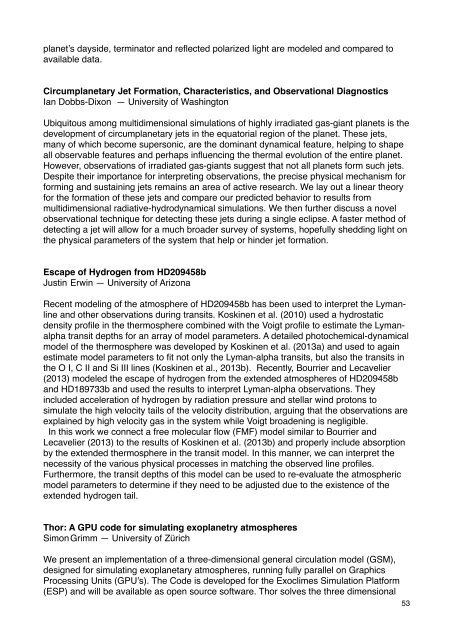Exoclimes_Conference_booklet1
Exoclimes_Conference_booklet1
Exoclimes_Conference_booklet1
Create successful ePaper yourself
Turn your PDF publications into a flip-book with our unique Google optimized e-Paper software.
planet’s dayside, terminator and reflected polarized light are modeled and compared to<br />
available data.<br />
Circumplanetary Jet Formation, Characteristics, and Observational Diagnostics<br />
Ian Dobbs-Dixon — University of Washington!<br />
Ubiquitous among multidimensional simulations of highly irradiated gas-giant planets is the<br />
development of circumplanetary jets in the equatorial region of the planet. These jets,<br />
many of which become supersonic, are the dominant dynamical feature, helping to shape<br />
all observable features and perhaps influencing the thermal evolution of the entire planet.<br />
However, observations of irradiated gas-giants suggest that not all planets form such jets.<br />
Despite their importance for interpreting observations, the precise physical mechanism for<br />
forming and sustaining jets remains an area of active research. We lay out a linear theory<br />
for the formation of these jets and compare our predicted behavior to results from<br />
multidimensional radiative-hydrodynamical simulations. We then further discuss a novel<br />
observational technique for detecting these jets during a single eclipse. A faster method of<br />
detecting a jet will allow for a much broader survey of systems, hopefully shedding light on<br />
the physical parameters of the system that help or hinder jet formation.<br />
Escape of Hydrogen from HD209458b!<br />
Justin!Erwin — University of Arizona!<br />
Recent modeling of the atmosphere of HD209458b has been used to interpret the Lymanline<br />
and other observations during transits. Koskinen et al. (2010) used a hydrostatic<br />
density profile in the thermosphere combined with the Voigt profile to estimate the Lymanalpha<br />
transit depths for an array of model parameters. A detailed photochemical-dynamical<br />
model of the thermosphere was developed by Koskinen et al. (2013a) and used to again<br />
estimate model parameters to fit not only the Lyman-alpha transits, but also the transits in<br />
the O I, C II and Si III lines (Koskinen et al., 2013b). Recently, Bourrier and Lecavelier<br />
(2013) modeled the escape of hydrogen from the extended atmospheres of HD209458b<br />
and HD189733b and used the results to interpret Lyman-alpha observations. They<br />
included acceleration of hydrogen by radiation pressure and stellar wind protons to<br />
simulate the high velocity tails of the velocity distribution, arguing that the observations are<br />
explained by high velocity gas in the system while Voigt broadening is negligible.<br />
In this work we connect a free molecular flow (FMF) model similar to Bourrier and<br />
Lecavelier (2013) to the results of Koskinen et al. (2013b) and properly include absorption<br />
by the extended thermosphere in the transit model. In this manner, we can interpret the<br />
necessity of the various physical processes in matching the observed line profiles.<br />
Furthermore, the transit depths of this model can be used to re-evaluate the atmospheric<br />
model parameters to determine if they need to be adjusted due to the existence of the<br />
extended hydrogen tail.<br />
Thor: A GPU code for simulating exoplanetry atmospheres<br />
Simon!Grimm — University of Zürich<br />
We present an implementation of a three-dimensional general circulation model (GSM),<br />
designed for simulating exoplanetary atmospheres, running fully parallel on Graphics<br />
Processing Units (GPU’s). The Code is developed for the <strong>Exoclimes</strong> Simulation Platform<br />
(ESP) and will be available as open source software. Thor solves the three dimensional<br />
53


